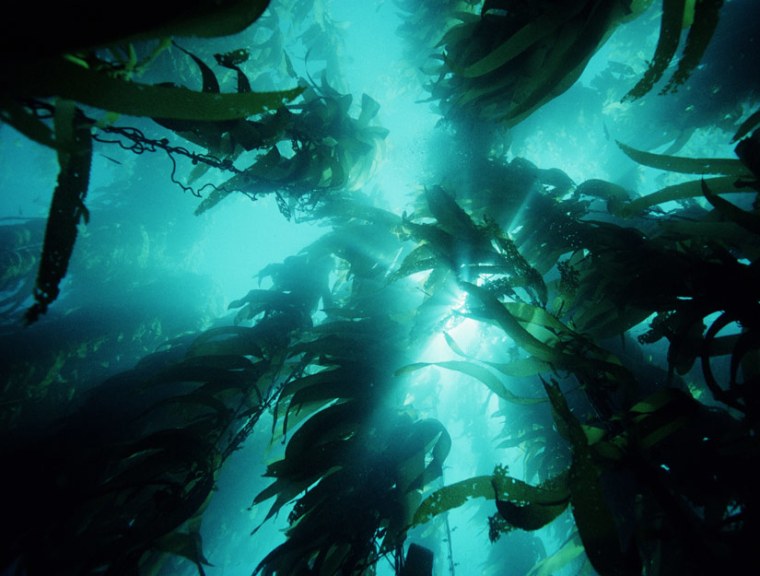Kelp and other seaweed could be biofuels of the future, avoiding competition with food crops for land and scarce freshwater resources — limitations that plague land-based biofuel prospects.
Researchers envision fast-growing cultivated kelp forests growing downward into the water, anchored on webs of rope, or porous sheets of material that roll with the waves. Offshore wind farms could be convenient places to grow seaweed biofuels in the future, some say.
So far, the process is not economical, but rising oil prices, or the possibility of first extracting higher-value products from the seaweed such as food additives or protein for fish food before converting the remainder to fuel, could change that.
"We've got a lot of seaweed growing out in the sea and we're not really using it. It's not taking up land. It's not food which could also be eaten," said Jessica Adams of Aberystwyth University in Wales.
"They grow very fast," added Yannick Lerat of the Technical Research Center on Seaweed in Pleubian, France. "The amount of organic matter you can produce per year per surface is about 10 times higher than you can find in croplands without GM organisms."
"There is no need to use freshwater," he continued. "Freshwater in some parts of the world is becoming really a tricky resource."
As with land plants, the carbohydrates in the tissues of seaweed can be converted in various ways to fuels. They can be burned via a process known as pyrolysis to make oil; fermented with bacteria into ethanol; or converted into methane via anaerobic digestion.
Because seaweed is buoyed by water, it does not need to make the woody compound lignin to help it stand up against gravity, like land plants do in growing their stalks and trunks.
Gnarly lignin resists degradation, a key obstacle in bringing terrestrial biofuels made from biomass such as corn stalks or tree crops to market. This makes seaweed easier to convert to fuels, researchers said.
"There are issues with harvesting it from the wild for it to be sustainable," said Michele Stanley of the Scottish Association of Marine Sciences, who is a leader of a program investigating fuels from seaweed. "We would support cultivation."
In Norway, wild kelp is harvested on a five-year rotation for production and sale of alginates — used as stabilizers and emulsifiers in foods, among other things. Wild harvest would not be feasible for the quantities needed for biofuels, Stanley said.
Pal Bakken, founder and head of Norwegian company Seaweed Energy Solutions AS, is working to develop better methods for cultivation.
His company has patented devices for growing kelp in sheets anchored to the seafloor at a single point, which allows the sheets to flow with the wave action, simulating a more natural growth environment.
This should allow simpler, cheaper cultivation and harvesting, he says, eliminating the tangly, multi-anchored rope systems of traditional Asian seaweed culture and perhaps making deeper waters available for cultivation.
Like land plants, kelp needs sufficient nutrients to grow, so it would need nitrogen fertilizer to grow in open water far from coastal nutrient sources.
But cultivated kelp could be a useful way to clean up waters full of nutrient runoff. For example, Norway's salmon farming releases enough nitrogen to support 9 million metric tons of kelp, Bakken said.
It is still unclear how the economics of seaweed biofuels shake out, according to experts. Stanley is investigating the question and hopes to have an answer in the next couple of years.
"There is no way this would be competitive on day one," Bakken said. "Incentives will be important in the beginning."
Lerat says oil prices will need to be somewhere around $300 a barrel before it's economical, but he and others say extracting higher-value chemicals first could change the equation.
"The more valuable things you can get out, the better," Adams said.
Indeed, the idea of the "biorefinery," analogous to the petrochemical refinery where high-value petrochemicals are taken out of crude oil before fuel is refined, is a popular vision of the future for terrestrial and marine biofuels alike.
Components of bioplastics, nutritional supplements, protein for fish food or even the phosphorus-laden ash from seaweed could be possible profit-turners. The remaining, carbohydrate-rich biomass could be fermented or digested to ethanol and methane for fuel.
Bakken notes that the available area for cultivation could be "almost unlimited and believes seaweed can make "a very large contribution" to the liquid fuels industry. His company claims that about 3.7 metric tons of kelp are needed to produce a barrel of ethanol.
Current global production is about 15 million metric tons, largely for alginate and food, and mostly in China and Japan. In a release from last year, Bakken's company reported that using 0.05 percent of Europe's coastal areas to cultivate kelp could supply 4.7 percent of the 2008 global ethanol production.
For now, the crop would be seasonal. Adams presented work this week at a meeting of the Society for Experimental Biology in Glasgow, Scotland, noting that carbohydrate levels in kelp on the Welsh coast rise tenfold from their wintertime lows to 35 to 40 percent in July, a finding that others have agreed with.
Seaweed crops would likely be bred for desirable attributes over time, including a longer cultivation season. Prudence would be needed in what species were introduced where, researchers agreed, to avoid problems with species invasions.
"I think this is really big," Bakken said. "It's not only the seaweed. It's the shift toward thinking 'blue.' We are so land-based. I think this will open up all kinds of industries related to the sea. It's finally beginning now."
